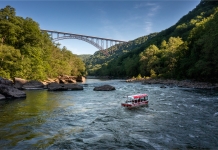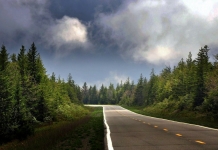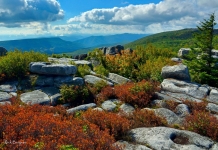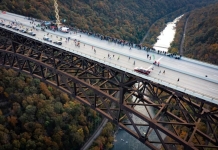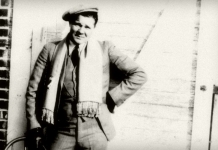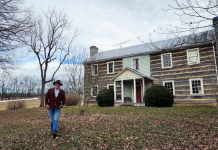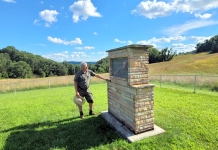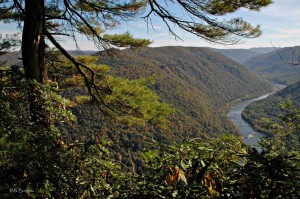
The 320-mile New River rises in the Blue Ridge region of North Carolina and flows northeastward through the Appalachian uplands to Radford, Va., where it turns northwestward and passes through a series of narrow valleys and gorges into southern West Virginia. It ends where it joins the Gauley River to form the Kanawha River. The New is considered by some geographers to be the Kanawha River and is often referenced as the Kanawha River.
In West Virginia, the New River flows through central Summers County, along the eastern flanks of Raleigh County, and through central and northwestern Fayette County. Between Hinton and its mouth at Gauley Bridge, the stream is entrenched in a steep and narrow valley, the most narrow part of which is known as the "New River Gorge."
The gorge was practically impassible before completion of the New River Gorge Bridge, near Fayetteville, WV, in 1978. The river within its gorge is one of the most popular whitewater rafting destinations in the eastern U.S. Much of the New between Hinton and Gauley Bridge is managed by the National Park Service as the New River Gorge National Park and Preserve.
Principal tributaries of the New in West Virginia include, from south to north, the East River, the Bluestone River, and the Greenbrier River.
History of the New River
The first recorded European exploration of the river was conducted in 1671 by a fur-trading expedition under the guidance of Thomas Batts and Robert Fallam and sent by Major General Abraham Wood. A variant name of the New is "Wood’s River," inspired by Abraham Wood. Some sources believe that the New River could have been discovered by Europeans as early as 1654.
New River Communities
From source to mouth, the following select cities, towns, and villages are located on or near the New River.
- Bellpoint, WV
- Avis, WV
- Hinton, WV
- Brooks, WV
- Sandstone, WV
- Meadow Creek, WV
- Quinnimont, WV
- Prince, WV
- Terry, WV
- Thayer, WV
- Thurmond, WV
- Fayetteville, WV
- Ansted, WV
- Gauley Bridge, WV
New River Ghost Towns
Many former mining communities located on the New River in its gorge have since become ghost towns. These include Sewell, Nuttalburg, Kaymoor, Fayette, South Fayette, Hawks Nest, Cotton Hill, and Gauley.
New River Parks & Preserves
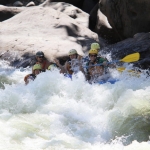
The New River in West Virginia has attracted the development of parks and protected areas, including the New River Gorge National Park and Preserve. The Bluestone Lake Wildlife Management Area and Bluestone State Park protects the southern reaches of the river downstream of the national river on Bluestone Lake. Babcock State Park as been developed on Manns Creek, a westward tributary of the New River located just upstream of the New River Gorge, and Hawks Nest State Park has been established on the cliffline at the downstream end of the gorge. The Boy Scouts of America host their Jamboree at the Bechtel National Scout Reserve on the gorge near Mount Hope, WV. Grandview and Sandstone Falls are two of the best known natural attractions on the river in West Virginia.
Name Origin
Accounts claim that Indians referred to the New River as the “river of death,” however this origin story is likely legend. Native Americans and early European settlers regarded the New and Kanawha rivers as being one single waterway. The name "New" may have been derived when the river upstream was discovered by European explorers as the first "new" river found flowing westward.
Regional Information
Information on lodging, dining, and recreation on and near the lower New River, downstream of Hinton, WV, may be found in our guide to travel in the New River Gorge Region. Information for the upper New River to the west, along the Bluestone River, may found in the Bluestone Region and to the east, along the Greenbrier River, in the Greenbrier Valley Region.
Through May 15, 2014: Help us build town info, and enter to win a raft trip!





